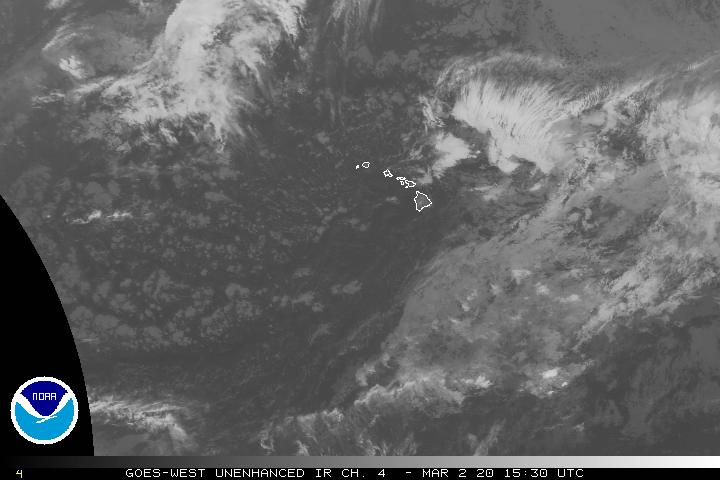Air Temperatures – The following high temperatures (F) were recorded across the state of Hawaii Wednesday…along with the low temperatures Wednesday:
85 – 73 Lihue, Kauai
88 – 75 Honolulu, Oahu
85 – 74 Molokai
87 – 73 Kahului AP, Maui
85 – 76 Kailua Kona
84 – 69 Hilo AP, Hawaii
Here are the latest 24-hour precipitation totals (inches) for each of the islands as of Wednesday evening:
0.03 Mount Waialeale Kauai
0.02 Poamoho RG 1, Oahu
0.20 Molokai
0.00 Lanai
0.04 Kahoolawe
0.41 West Wailuaiki, Maui
0.87 Kawainui Stream, Big Island
The following numbers represent the strongest wind gusts (mph) as of Wednesday evening:
30 Port Allen, Kauai
27 Kuaokala, Oahu
27 Molokai
29 Lanai
32 Kahoolawe
35 Maalaea Bay, Maui
35 Puu Mali, Big Island
Hawaii’s Mountains – Here’s a link to the live webcam on the summit of our tallest mountain Mauna Kea (nearly 13,800 feet high) on the Big Island of Hawaii. This webcam is available during the daylight hours here in the islands, and at night whenever there’s a big moon shining down. Also, at night you will be able to see the stars — and the sunrise and sunset too — depending upon weather conditions.
Aloha Paragraphs

An out of season cold front…approaching from the north

An upper level low pressure system southwest of Kauai

Areas of higher level clouds offshore

Showers locally – Looping radar image
~~~ Hawaii Weather Narrative ~~~
Broad Brush Overview: Moderate trade winds are expected to prevail during the next week, with a trend toward lighter winds possible over the weekend. A relatively dry weather pattern will continue over most areas for the next day or so, with just a few windward showers. An increase in windward showers is expected Friday into the weekend, as moisture associated with a dissipating cold front moves over the area from the north. Trade wind showers may stay active through early next week…as a weak disturbance aloft will develop nearby.
Details: These late spring trade winds will persist, supported by high pressure well north of the islands. The high will move toward the northeast over the next couple of days. As the high passes northeast of the islands Friday into the weekend, shallow moisture associated with an old cold front 200+ miles north of Kauai, will continue to sag slowly south towards the islands. This out of season frontal cloud band will bring windward clouds and showers initially to Kauai Thursday and Thursday night…spreading to Oahu and Maui County Friday into Saturday.
Looking Further Ahead: Models indicate that a somewhat showery weekend is in store, at least over windward areas of the smaller islands, with the Big Island potentially not receiving windward showers until later in the weekend. This pattern continues through a good portion of next week as models keep above normal moisture embedded within the trade wind flow…while a weak low aloft develops near or west of the islands.
If this all sounds very unusual for this time of year…you’re absolutely right! The models continue to insist on this out of season frontal boundary making it to the islands, so I have a difficult time negating the possibility. However, I must say that I’ll be surprised, although very happy, if this manifests as the models show. We could definitely use the water, as we head towards our normally dry summer season.
Here’s a wind profile of the Pacific Ocean – Closer view of the islands / Here’s the vog forecast animation / Here’s the latest weather map
Marine environment details: Trade winds will continue to slowly decline through the rest of the week. As a result, the Small Craft Advisory has been discontinued over all Hawaiian waters. Breezy conditions will persist over the typically windy areas around the Big Island and Maui through the end of the work week.
Moderate trade winds will maintain relatively small wind waves along most windward shores through this weekend. Small swells from the northwest, north, and southeast are possible through the rest of the week as well…although surf along all shores will remain well below the High Surf Advisory level. A small south-southwest swell may arrive Thursday and continue through Saturday.
The coastal waters, especially north and west of the Big Island, will see more showery conditions toward the end of the work week, as a dissipating, although moisture laden frontal boundary pushes across the area from north to south.

Small to very small surf all shores…a bit larger windward sides
>>> Southern California Weather Brief: An onshore flow will result in persistent low stratus clouds, which will dominates sky conditions well inland. Temperatures will be slightly below normal through Friday, becoming even cooler this weekend. Gusty northerly winds are possible Friday and Saturday.

Low clouds extending inland varying distances…streaky high clouds
World-wide tropical cyclone activity
![]()
>>> Atlantic Ocean: No active tropical cyclones
>>> Caribbean: No active tropical cyclones
>>> Gulf of Mexico: No active tropical cyclones
Here’s a satellite image of the Caribbean Sea…and the Gulf of Mexico
Here’s the link to the National Hurricane Center (NHC)
>>> Eastern Pacific: No active tropical cyclones
Here’s a wide satellite image that covers the entire area between Mexico, out through the central Pacific…to the International Dateline.
Here’s the link to the National Hurricane Center (NHC)
>>> Central Pacific: No active tropical cyclones
Here’s the NOAA 2016 Hurricane Season Summary for the Central Pacific Basin
Here’s a link to the Central Pacific Hurricane Center (CPHC)
>>> Northwest Pacific Ocean: No active tropical cyclones
>>> North and South Indian Oceans / Arabian Sea: No active tropical cyclones
Here’s a link to the Joint Typhoon Warning Center (JTWC)
Interesting: Offshore wind turbines vulnerable to Category 5 hurricane gusts – Offshore wind turbines built according to current standards may not be able to withstand the powerful gusts of a Category 5 hurricane, creating potential risk for any such turbines built in hurricane-prone areas, new University of Colorado Boulder-led research shows.
The study, which was conducted in collaboration with the National Center for Atmospheric Research in Boulder, Colorado, and the U.S. Department of Energy’s National Renewable Energy Laboratory in Golden, Colorado, highlights the limitations of current turbine design and could provide guidance for manufacturers and engineers looking to build more hurricane-resilient turbines in the future.
Offshore wind-energy development in the U.S. has ramped up in recent years, with projects either under consideration or already underway in most Atlantic coastal states from Maine to the Carolina’s, as well as the West Coast and Great Lakes. The country’s first utility-scale offshore wind farm, consisting of five turbines, began commercial operation in December 2016 off the coast of Rhode Island.
Turbine design standards are governed by the International Electro-technical Commission (IEC). For offshore turbines, no specific guidelines for hurricane-force winds exist. Offshore turbines can be built larger than land-based turbines, however, owing to a manufacturer’s ability to transport larger molded components such as blades via freighter rather than over land by rail or truck.
For the study, CU Boulder researchers set out to test the limits of the existing design standard. Due to a lack of observational data across the height of a wind turbine, they instead used large-eddy simulations to create a powerful hurricane with a computer.
“We wanted to understand the worst-case scenario for offshore wind turbines, and for hurricanes, that’s a Category 5,” said Rochelle Worsnop, a graduate researcher in CU Boulder’s Department of Atmospheric and Oceanic Sciences (ATOC) and lead author of the study.
These uniquely high-resolution simulations showed that under Category 5 conditions, mean wind speeds near the storm’s eyewall reached 90 meters-per-second, well in excess of the 50 meters-per-second threshold set by current standards (157+ mph).
“Wind speeds of this magnitude have been observed in hurricanes before, but in only a few cases, and these observations are often questioned because of the hazardous conditions and limitations of instruments,” said George Bryan of NCAR and a co-author of the study. “By using large-eddy simulations, we are able to show how such winds can develop and where they occur within hurricanes.”
Furthermore, current standards do not account for veer, a measure of the change in wind direction across a vertical span. In the simulation, wind direction changed by as much as 55 degrees between the tip of the rotor and its hub, creating a potentially dangerous strain on the blade.
The findings could be used to help wind farm developers improve design standards as well as to help stakeholders make informed decisions about the costs, benefits and risks of placing turbines in hurricane-prone areas.
“The study will help inform design choices before offshore wind energy development ramps up in hurricane-prone regions,” said Worsnop, who received funding from the National Science Foundation Graduate Research Fellowship Program to conduct this research. “We hope that this research will aid wind turbine manufacturers and developers in successfully tapping into the incredibly powerful wind resource just beyond our coastlines.”
“Success could mean either building turbines that can survive these extreme conditions, or by understanding the overall risk so that risks can be mitigated, perhaps with financial instruments like insurance,” said Professor Julie Lundquist of ATOC and CU Boulder’s Renewable and Sustainable Energy Institute (RASEI), a co-author of the study. “The next stage of this work would be to assess how often these extreme winds would impact an offshore wind farm on the Atlantic coast over the 20-to-30-year lifetime of a typical wind farm.”
The findings were recently published online in the journal Geophysical Research Letters, a publication of the American Geophysical Union.
– Hawaii has become the first American state to pass environmental measures that adhere to the Paris climate agreement, just days after President Donald Trump announced the U.S. withdrawal from the international pact.
“Truly, in this day and age, it is time for states and governors to lead,” Hawaiian Gov. David Ige (D) said at a press conference on Tuesday, ahead of signing the two bills into law.
Senate Bill 559 and House Bill 1578 commit to expanding methods to reduce greenhouse gas emissions across the state. They also target agricultural practices with the goals of improving soil health and removing carbon dioxide from the atmosphere, according to a statement from the governor’s office.
“Hawaii’s natural environment is under threat,” Ige said. “Climate change is real, regardless of what others say. Hawaii is seeing the impacts, first hand.”
Sen. J. Kalani English (D), who introduced SB 559, recognized it as a “legal basis to continue adaption and mitigation strategies” for the state, “despite the federal government’s withdrawal from the treaty,” according to ABC News.
The bills’ signage came with the support of four Hawaiian County mayors, who have joined hundreds of other mayors across the U.S. in signing a commitment agreement.
“We will intensify efforts to meet each of our cities’ current climate goals, push for new action to meet the 1.5 degrees Celsius target, and work together to create a 21st century clean energy economy,” declared the mayors, who referred to themselves as “Climate Leaders” in a statement following Trump’s decision to withdraw from the pact on Thursday.












 Email Glenn James:
Email Glenn James:
Douglas MacDougal Says:
Aloha Glen
Happy birthday to your mother from Sydney. She seems to be quite a resilient Lass, ably assisted by a loving family.
Douglas
~~~ Hi Douglas, thanks so much for your kind Happy Birthday wishes for my Mom! Indeed, she has made it a long ways in life, and continues to be generally healthy.
Thanks for writing from all the way down in Sydney, Australia!
Aloha, Glenn
Helen Says:
That was a birthday cake icon not question marks! Many happy returns of the day! !
~~~ Thanks Helen, my Mom had a real slice of chocolate Birthday cake as it turned out.
Aloha, Glenn
Helen Says:
Yes Happy Birthday Mrs James !!’ ????
~~~ Hi Helen, thanks for your well wishes for me Mom!
Aloha, Glenn
Zee Says:
Hi Glenn,
big fan of your website. Hope you don’t mind me asking – I’m getting married on the windward shores of North Kauai next Wed and Thurs. Based on your report, would you say we should be prepared for noticeably wet weather?
Thanks!
Zee
~~~ Hi Zee, first of all congratulations!
As for the latest forecast for the windward side of Kauai next Wednesday:
Partly sunny with scattered showers. Highs 74 to 88. Southeast winds up to 10 mph shifting to the southwest early in the afternoon, then shifting to the southeast late in the afternoon. Chance of rain 50 percent.
You can use this link (http://www.hawaiiweathertoday.com/kauai.php?zone=HIZ003) for the latest updates on this forecast.
Best of luck!
Aloha, Glenn
Myrtle Says:
Happy Birthday Dorothy! Have some fun and enjoy the beautiful full moon!
Aloha,
Myrtle
~~~ Oh hi Myrtle, thank you so much, we’ll enjoy this month’s full moon on the 9th!
Aloha, Glenn